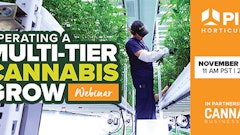9 Tips to Defoliate a Cannabis Canopy
Welcome to this week’s episode of “Tricks of the Trade”!

In the third installment of this four-part video series, the Cannabis Business Times team is featuring “How to Defoliate a Canopy,” and we’re back at Buckeye Relief, a Northeast Ohio cultivator and processor with vertical grows and movable racking on Cleveland’s east side.
Defoliation is a process that can vary from grow to grow and from room to room, depending on the cultivar being grown, the environment the plant is in, and how the plant is being cared for. But the end goals remain constant: increase airflow and allow light penetration.
In this “how-to” demonstration suite, which spotlights the day-to-day operations of cannabis industry professionals, we’ve also underscored "How to Infuse Chocolate” and “How to Fill Vape Carts.” Stay tuned for our season finale, “How to Freeze Dry Cannabis Flower,” on Feb. 13.

In the meantime, in this Feb. 6 video, Vice President of Cultivation Matt Kispert, Cultivation Director Tyler Bracken, and Irrigation and Controls Director Zack Folino show us their defoliation process in one of Buckeye Relief’s flowering rooms. And they’re working with sativa-dominant 92 Cookies (Girl Scout Cookies x Blue Dream x Ghost OG x 92 OG)—a fan favorite among patients in Ohio’s medical market.
“The whole goal we have here today is to open up this canopy, allow the sunlight to come through … [and] to let the airflow come through the canopy as well,” Bracken says. “We want every single one of these bud sites to get as much light flow to it.”
Bracken began working at Buckeye Relief in 2018 as an intern and worked his way up through management to his director role, while Kispert is a horticulturist and greenhouse manager by trade—with a master’s degree in horticulture—and Folino has worked in the company’s irrigation and controls department for roughly three years. He has a degree in agricultural engineering.

Here, they share 9 tips from their defoliation process:
1. Know Your Facility: The defoliation process can vary among indoor, greenhouse and outdoor environments.
The indoor environment poses a lot of unique challenges, particularly with airflow, Kispert says.
“A big reason that we defoliate is to open up the canopies, allow increased air circulation within the canopies and maximize the amount of light that penetrates into the canopy,” he says. “So, we’re trying to basically produce a plant that’s more uniform from top to bottom. And we do that by essentially making the canopy more uniform through selective removal of branches and leaves—defoliation.”
Specifically for an indoor grow, like the one at Buckeye Relief, irrigation, nutrient and light controls play a factor in the selectiveness of the defoliation process. Whereas at a large outdoor operation, for example, cannabis plants may (or may not) need to keep more of their leaves to retain water and nutrients in times of drought or other natural events that cause stress.
2. Proper Irrigation: Make sure your plants’ water and nutrient levels are stable before defoliating.
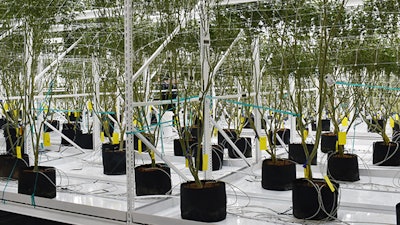
When it comes to providing irrigation, the plants themselves have an internal force called turgor pressure, which keeps them standing up and erect throughout their life cycles, Folino says.
“Making sure that they have the proper amount of water in their cells really pushes those leaves out,” he says. “If we don’t properly irrigate them before we go through and defoliate these plants, they get that floppiness and droopiness to them, and then you get a lot more stripping [versus a clean break when removing fan leaves].”
Editor’s note: As Bracken explains in this video, stripping creates an open wound and can cause vectors for mold or other unwanted conditions. More details are below in tips No. 5 and No. 6.
When leaves or branches are removed during defoliation, the plant’s bud sites have fewer points to draw from when water or nutrients are needed to continue their growth phases.
“[Drooping] is their natural reaction; they don’t want to exert energy to push out on their cell walls,” Folino says. “They’ll save that energy for something else and try not to die throughout their lives, so that’s why we’ll see that. Definitely providing that energy for them and that water is super important for an event like this.”
3. Find Middle Ground: Removing too many leaves or doing so too often can work against you.

One of the biggest risks involved with over-defoliation is throwing off the source-sink balance of the cannabis plants, Kispert says.
“If you think about the leaves as a power ‘source’ and buds as a power ‘sink,’ we need to have a good ratio of source-to-sink in order to get a viable yield,” he says. “The more leaves you pluck off, the more you’re restricting the amount of energy that plant can produce, and that energy goes into bud production, which is ultimately why we’re here.”
Leaving enough material on the plants to provide that energy to grow properly, but not too much to where unwanted microclimates create unnecessary disease risk, is the name of the game, Kispert says. Factoring in light penetration, it becomes a fine balance, he says.
Another issue with removing too much material is stressing the plants.
“There are a lot of plants that have what they call an herbivore feeding response, where basically damage to the plant causes a change in the hormones produced in the plant and it can have some deleterious effects,” Kispert says. “Cannabis, in particular, has been known to throw male flowers when stressed out. So, over-pruning a plant can actually cause some weaker phenotypes to herm[aphrodite] out and produce male flowers.”
4. Timing: Schedule the correct phases of the grow cycle for defoliation.
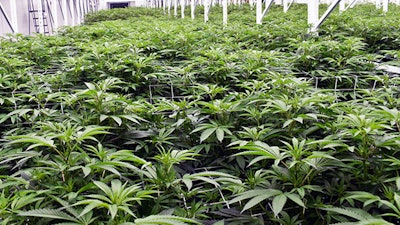
The team at Buckeye Relief will prune and defoliate their cannabis plants once during the vegetative growth stage right before they move into flower, Bracken says.
After the transition to the flowering stage, the team will prune the plants in week two and then hit defoliation in week four, he says.
“During that prune, we’re setting ourselves up for the future, which is the defoliation in week four,” Bracken says. “Whenever we do prune, we will use snips because the branches don’t snap off like a fan leaf does [during defoliation by hand].”
In addition, the Buckeye Relief team will thin out its plants during their “mini veg” stage, but that’s more of a spot defoliating process, Bracken says.
5. The Process: Remove the fan leaves from the stems.
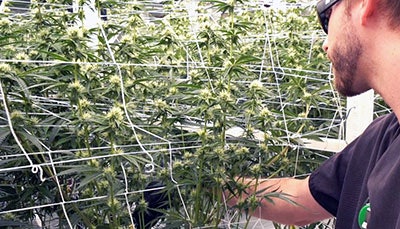
When removing a fan leaf from its stem, feel for a nice snap (a clean break), Bracken says.
“We don’t want to leave any petiole behind, because that is a nice vector for molds and different things we don’t want to attack an open wound,” he says.
Bracken likes to start the process at the top of an open branch and work his way down, snapping off every big fan leaf that is overcrowding the center of the plant. Once he gets down to the bottom of a branch, he’ll come back up a neighboring branch.
“Whenever I’m coming up, I’m going to be leaving the top couple fan leaves, because we don’t want to disrupt the top cola,” he says. “I’ll take out all of these fan leaves that are bunching up the center of the plant, and we’ll make it so the plant itself has a bunch of airflow through it.”
When Bracken is done plucking the fan leaves from any given plant in the defoliation process, he inspects the plant and moves any branches that are too close together to an open square in the trellis netting to ensure proper spacing.
6. Training: Take the time to properly educate your staff.
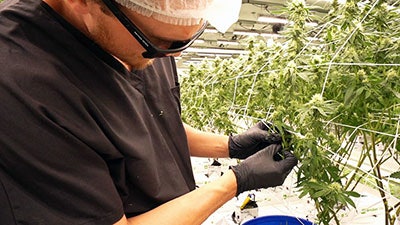
Much like the saying “a chain is only as strong as its weakest link,” it takes a well-trained cultivation team to uniformly defoliate an entire canopy at a large-scale facility.
“Some of the major things we see with a beginner when they’re starting out defoliating is they’ll sometimes not get the petiole in the right area,” Bracken says. “So, the petiole will end up causing a stripping down the branch. And that’s something that we really try to pick up on right when it happens so that person understands what’s going on.”
Also, Bracken says, the petiole doesn’t break off cleanly every time. Sometimes half of the petiole will break off, which leaves an open end of that petiole.
“It’s a nice spot for mold to go into and things like that,” he says. “Eventually, you know what a petiole feels like compared to a branch. When your arms are inside the canopy, you’re trying to take as many leaves as possible while you’re in there so there’s not as many times in and out of the canopy. So, you really do get to know the feel of a petiole and a branch.”
7. Have SOPs: Collect data, analyze and adjust.
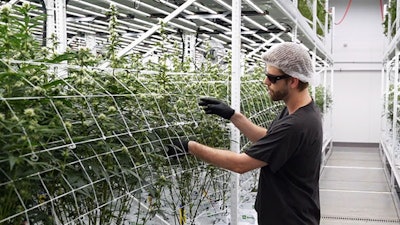
The importance of Standard Operating Procedures, or SOPs, is a ubiquitous theme throughout the cannabis industry, and other industries as well. But it’s also important to note that cannabis grows are somewhat unique based on facility, specific cultivars, and the like.
At Buckeye Relief, for example, the 92 Cookies cultivar featured in this video is one of the tallest plants grown at the facility, so the cultivation team cut down the veg cycle by two weeks to manipulate the height it finishes at and to ensure it doesn’t get too close to the lights.
Data collection on myriad cultivation components plays a vital role in the overall health and final yield of any harvest, says Kispert, whose master’s degree included a focus on crop scheduling and production.
“We operate everything based off of observations and historical recorded data,” the cultivation VP says. “So, everything from the height of the nets to the spacing of the plants on the tables, how many plants per table we put down, what varieties we grow next to other varieties—all of that comes from observations and recorded data.”
The Buckeye Relief cultivation team routinely collects and records height measurements, bud circumferences and even stem counts for varieties from time to time.
“We tend to grow our new varieties and then try to place them in buckets based on their overall morphology,” Kispert says. “That gives us an idea of how they’re going to play with other plants should plants have to share a table or should plants be next to each other on adjacent rows—all of that ties in, as well as the veg time that we give them.”
Before introducing new cultivars at scale, Buckeye Relief’s team members have what Kispert calls a “sneak peek” program, where they’ll grow small amounts, make observations, move it around in a grow room, try different irrigation zones, take height measurements, and develop a cultivation profile of the plant before they consider it as a production strain.
“And then once we have that profile down, along with our yield and lab testing data, we decide what we want to do with the variety—either push it into full production or cease production on it entirely,” Kispert says.
8. Take Care of Your Workers: Defoliation is strenuous for both plants and people.
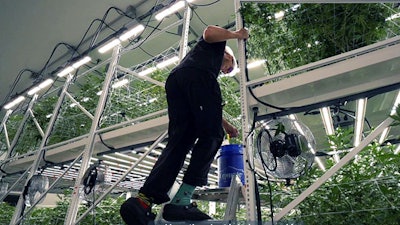
Buckeye Relief’s flower room showcased in this video is two-tiered with movable racking, and the defoliation process can be an arduous task for cultivators who don’t have the proper equipment to access the upper level, Folino says.
“We have pretty much been through almost every variation of ways of getting up there that you can probably imagine,” he says. “Some of the things that we’ve used is rolling step ladders. We’ve used basic step ladders. We’ve even used things like that yellow scaffolding that you’ll see on construction sites.”
The Buckeye Relief team ended up working with Pipp Horticulture—provider of its mobile vertical grow racking system—to develop a catwalk system.
“That really changed the game and made accessing that level a lot easier and way more comfortable for the employees, because events like defoliation, they can be pretty long and tedious and strenuous on people’s body,” Folino says. “We just want to eliminate that altogether.”
9. Be Mindful of Movable Racking: Have SOPs for resting positions and make sure your cultivation team follows through.

One of the two main purposes for defoliation at an indoor facility is to increase airflow so fan leaves don’t overtake a space, sweat and create microclimates. When done correctly, defoliation helps cultivators control their environment.
But with movable racking, one more factor is added into that equation—proper resting positions—Folino says.
“If we leave rows smashed together for too long of periods, they increase in humidity, increase in temperature; there’s really not as much airflow going through there,” he says. “So, we just try to keep them as separated as possible throughout the day.”
When the cultivation crew members leave for the day or exit any given grow room, the standard operator procedure is for them to separate the rows evenly and not leave a big aisleway open, Folino says. Communicating with team members why that procedure is in place allows them to understand the importance of resting positions and follow through on following the procedure.





















